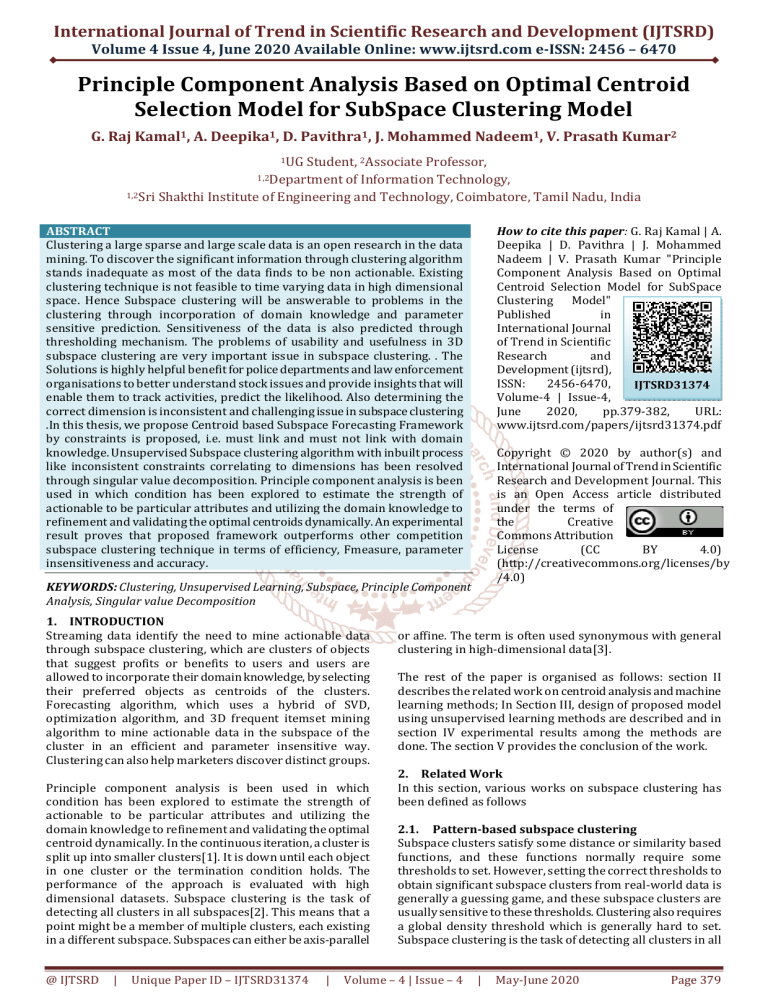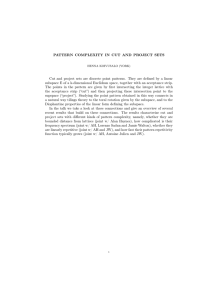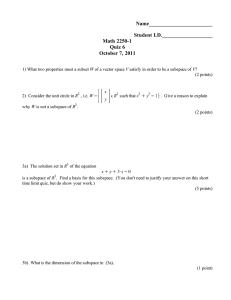
International Journal of Trend in Scientific Research and Development (IJTSRD)
Volume 4 Issue 4, June 2020 Available Online: www.ijtsrd.com e-ISSN: 2456 – 6470
Principle Component Analysis Based on Optimal Centroid
Selection Model for SubSpace Clustering Model
G. Raj Kamal1, A. Deepika1, D. Pavithra1, J. Mohammed Nadeem1, V. Prasath Kumar2
1UG
Student, 2Associate Professor,
1,2Department of Information Technology,
1,2Sri Shakthi Institute of Engineering and Technology, Coimbatore, Tamil Nadu, India
How to cite this paper: G. Raj Kamal | A.
Deepika | D. Pavithra | J. Mohammed
Nadeem | V. Prasath Kumar "Principle
Component Analysis Based on Optimal
Centroid Selection Model for SubSpace
Clustering Model"
Published
in
International Journal
of Trend in Scientific
Research
and
Development (ijtsrd),
ISSN:
2456-6470,
IJTSRD31374
Volume-4 | Issue-4,
June
2020,
pp.379-382,
URL:
www.ijtsrd.com/papers/ijtsrd31374.pdf
ABSTRACT
Clustering a large sparse and large scale data is an open research in the data
mining. To discover the significant information through clustering algorithm
stands inadequate as most of the data finds to be non actionable. Existing
clustering technique is not feasible to time varying data in high dimensional
space. Hence Subspace clustering will be answerable to problems in the
clustering through incorporation of domain knowledge and parameter
sensitive prediction. Sensitiveness of the data is also predicted through
thresholding mechanism. The problems of usability and usefulness in 3D
subspace clustering are very important issue in subspace clustering. . The
Solutions is highly helpful benefit for police departments and law enforcement
organisations to better understand stock issues and provide insights that will
enable them to track activities, predict the likelihood. Also determining the
correct dimension is inconsistent and challenging issue in subspace clustering
.In this thesis, we propose Centroid based Subspace Forecasting Framework
by constraints is proposed, i.e. must link and must not link with domain
knowledge. Unsupervised Subspace clustering algorithm with inbuilt process
like inconsistent constraints correlating to dimensions has been resolved
through singular value decomposition. Principle component analysis is been
used in which condition has been explored to estimate the strength of
actionable to be particular attributes and utilizing the domain knowledge to
refinement and validating the optimal centroids dynamically. An experimental
result proves that proposed framework outperforms other competition
subspace clustering technique in terms of efficiency, Fmeasure, parameter
insensitiveness and accuracy.
Copyright © 2020 by author(s) and
International Journal of Trend in Scientific
Research and Development Journal. This
is an Open Access article distributed
under the terms of
the
Creative
Commons Attribution
License
(CC
BY
4.0)
(http://creativecommons.org/licenses/by
/4.0)
KEYWORDS: Clustering, Unsupervised Learning, Subspace, Principle Component
Analysis, Singular value Decomposition
1. INTRODUCTION
Streaming data identify the need to mine actionable data
through subspace clustering, which are clusters of objects
that suggest profits or benefits to users and users are
allowed to incorporate their domain knowledge, by selecting
their preferred objects as centroids of the clusters.
Forecasting algorithm, which uses a hybrid of SVD,
optimization algorithm, and 3D frequent itemset mining
algorithm to mine actionable data in the subspace of the
cluster in an efficient and parameter insensitive way.
Clustering can also help marketers discover distinct groups.
Principle component analysis is been used in which
condition has been explored to estimate the strength of
actionable to be particular attributes and utilizing the
domain knowledge to refinement and validating the optimal
centroid dynamically. In the continuous iteration, a cluster is
split up into smaller clusters[1]. It is down until each object
in one cluster or the termination condition holds. The
performance of the approach is evaluated with high
dimensional datasets. Subspace clustering is the task of
detecting all clusters in all subspaces[2]. This means that a
point might be a member of multiple clusters, each existing
in a different subspace. Subspaces can either be axis-parallel
@ IJTSRD
|
Unique Paper ID – IJTSRD31374
|
or affine. The term is often used synonymous with general
clustering in high-dimensional data[3].
The rest of the paper is organised as follows: section II
describes the related work on centroid analysis and machine
learning methods; In Section III, design of proposed model
using unsupervised learning methods are described and in
section IV experimental results among the methods are
done. The section V provides the conclusion of the work.
2. Related Work
In this section, various works on subspace clustering has
been defined as follows
2.1. Pattern-based subspace clustering
Subspace clusters satisfy some distance or similarity based
functions, and these functions normally require some
thresholds to set. However, setting the correct thresholds to
obtain significant subspace clusters from real-world data is
generally a guessing game, and these subspace clusters are
usually sensitive to these thresholds. Clustering also requires
a global density threshold which is generally hard to set.
Subspace clustering is the task of detecting all clusters in all
Volume – 4 | Issue – 4
|
May-June 2020
Page 379
International Journal of Trend in Scientific Research and Development (IJTSRD) @ www.ijtsrd.com eISSN: 2456-6470
subspaces. This means that a point might be a member of
multiple clusters, each existing in a different subspace.
Subspaces can either be axis-parallel or affine[4].
Hierarchical Spatio-Temporal Pattern Discovery
and Predictive Modelling
CCRBoost, to identify the hierarchical structure of spatiotemporal patterns at different resolution levels and
subsequently construct a predictive model based on the
identified structure[4]. To accomplish this, we first obtain
indicators within different spatio-temporal spaces from the
raw data.
Feature Classification is carried out the dataset into
categories with deduced attributes.
Attribute Reduction has been carried out to eliminate
irrelevant attributes of the dataset.
2.2.
A distributed spatio-temporal pattern (DSTP) is extracted
from a distribution, which consists of the locations with
similar indicators from the same time period, generated by
multi-clustering. Next, we use a greedy searching and
pruning algorithm to combine the DSTPs in order to form an
ensemble spatio-temporal pattern (ESTP). An ESTP can
represent the spatio-temporal pattern of various regularities
or a non-stationary pattern to determine the trend of the
crime data growing in the specific region on year and state
wise visualization of the dataset.
Hence, we propose mechanism to efficiently prune tensor in
a parameter-free way, by using the variance of the data to
identify regions of high homogeneity values. The figure 1
represents the proposed architecture.
3.3. Principle Component analysis
Principle Component analysis is applied towards analyzing
and grouping of data is required for better understanding
and examination [7]. Strategy for finding the local maxima
and minima of a function subject to equality constraints has
been identified on basis of the feature of the dataset in the
different time frame.
2.3.
Prophet model for Predictive Modelling and
Visualization
The Prophet model is a procedure for forecasting time series
data based on an additive model where non-linear trends are
fit with yearly, weekly, and/or daily seasonality, plus holiday
effects. It works best with time series that have strong
seasonal effects and cover several seasons of historical data.
The Prophet model is robust to missing data and shifts in the
trend, and typically it handles outliers well. The Prophet
model is designed to handle complex features in time series;
it also designed to have intuitive parameters that can be
adjusted without knowing the details of the underlying
model [5].
3. Proposed methodology
3.1. Data Preprocessing
The high dimensional data considered in form as synthesis
dataset as its contains more information with several
attributes along huge records in difference time factors to
analyse for providing accurate predictions in future cases[5].
It undergo data normalization, missing value prediction and
data reduction.
3.2. Singular Value Decomposition
Actionable 3D Subspace clustering undergoes dimensionality
reduction due to the high-dimensional and continuousvalued tensor data for difficult and time-consuming process.
Hence, it is vital to first remove regions that do not contain
CATs. A simple solution is by removing values that are less
than a threshold, but it is impossible to know the right
threshold[6].
On Data Acquisition, series of preprocessing step has been
carried which is as follows
Time based data is discretized into a couple of columns
to allow for time series forecasting for the overall trend
within the acquired data to generate effective feature
space.
Missing Value Prediction using random value samples
has been carried out the data acquired with missing
values.
@ IJTSRD
|
Unique Paper ID – IJTSRD31374
|
Figure 1: Architecture of the proposed model
It yields a necessary condition for optimality of the
cluster[8].
Algorithm: Optimal Centroid Selection
Input
is the 3D Data Cluster
Output: Actionable Data µ
Description:
Calculate the Probability of the Data based on the time
constraint “T”
Condition p(T) max (
Calculate the thresholds Tu and Tl
Use SVD Pruning for dummy value and high changeable
data’s
if (
Tu |Tl)
Else
Check the
Volume – 4 | Issue – 4
to the next value
|
May-June 2020
Page 380
International Journal of Trend in Scientific Research and Development (IJTSRD) @ www.ijtsrd.com eISSN: 2456-6470
The Prophet model decomposes time series into three main
components. That main component has been processed
further on basis of Principle Component Analysis (PCA). It is
computed using covariance and correlation matrix which is
given as
Association Matrix A =
cov(a, a ) cov(a, b) cov(a, c)
= cov(b, a ) cov(b, b) cov(b, c )
cov(c, a ) cov(c, b) cov(c, c )
Figure 2: Performance Evaluation of proposed model
against existing model
The figure 2 represents the performance of the proposed
model. The proposed utility helps to improve the clustering.
Centroid-based subspace clustering finds any cluster
because it strictly requires a cluster to occur in every time
stamp [10].
Matrix value is represented as
Aij =
1 n
∑ (d1 − X i )(dn − X j ) + Xi
n − 1 m =1
Identifying patterns from vast amounts of data streams and
identifying members of a predefined class, which is called
classification, have become critical tasks Class formation is
carried out through classifier which is classified into
parametric and nonparametric classifiers. Significant
instance are clustered and notified to police department
intrinsically prominent in the data.
The class characteristics in terms of changes in the feature
space covered by a class will provide the recurring classes
prediction
Region of the feature space defined by the decision boundary
of class c just before the class disappeared from the stream.
Calculate the Probability of the Data based on the time
constraint “T”
Condition p(T) max (
Calculate the thresholds Tu and Tl
Use SVD Pruning for dummy value and high changeable
data’s
Extract ()
Feature set = {V1(x, y), V2(x, y)...}
if (
Tu|Tl)
Predict ()
to the next value.
4. Experimental Results
Experiment analysis has been carried out on efficiency
analysis. It broadly represents the different classes of
subspace clustering [9]. All experiments were performed
using computers with Intel Core 2 Quad 3.0 GHz CPU, 8 GB
RAM. In this parameter insensitive and default parameter
setting.
|
Unique Paper ID – IJTSRD31374
The Correlation of the Attribute is calculated based on the
similarity and distance function using correlation coefficient.
The Coefficient measures the correlation between pairs of
columns to remove one of two highly correlated data
columns. Furthermore, if any earlier process reappears, the
data can be handled effectively. It is complex to process the
massive data. It Classifies according to their internal
relevance on representative features.
The cluster has been employed to identify and realize a
trade-off between precision and computation cost values. In
this training clusters provides is no deviation on data
association on clusters and between clusters. After
computing the distance, sorting has to be made in ascending
order to extract the results. It uses the Covariance matrix
and correlation matrix for similarity computation.
In addition to concept and semantic of the data, features of
the data tends to evolve, which can handled using ensemble
model.
The prediction models employed in this section has
capability to learn complex functions and data structures
while irrelevant variations are suppressed.hih performance
has been achieved in determining the data structure of large
scale data.
@ IJTSRD
Table 1: Performance Evaluation of the Proposed
model
Technique Precision Execution time
Existing
82.23
56ms
Proposed
96.23
37ms
Table 1 provides the performance computation of significant
clusters is intrinsically prominent in the data, and they are
usually small in numbers.
For L > Lm
Else
Check the
The different technique employed for Stock prediction on
various trend analyses using mining of cluster through
approximation with cluster indices of the data interactions.
|
Conclusion
We have developed forecasting technique to Exploring
dimension in subspace clustering for value decomposition to
Mining actionable 3 D subspace clusters from continuous
valued 3D (object-attribute-time) data is useful in domains
ranging from finance to biology. But this problem is
nontrivial as it requires input of users’ domain knowledge,
clusters in 3D subspaces, and parameter insensitive and
efficient algorithm. We developed and utilized a novel
algorithm forecasting using PCA principles to mine subspace
data, which concurrently handles the multifacets of this
problem.
Volume – 4 | Issue – 4
|
May-June 2020
Page 381
International Journal of Trend in Scientific Research and Development (IJTSRD) @ www.ijtsrd.com eISSN: 2456-6470
We also found the PCA based Prophet Model with LSTM
algorithm optimal time period for the training sample to be
10 years, in order to achieve the best prediction of trends in
terms of Accuracy. Optimal parameters for the Prophet and
the LSTM models are also determined.
[7] B. Graham, The Intelligent Investor: A Book of Practical
Counsel. Harper Collins Publishers, 1986.
In our experiments, we verified the effectiveness of PCA in
synthetic data. In financial application, we show that
forecasting technique is 70-80 percent better than the next
best competitor in the return/risk (maximizing profits over
risk) ratio. Hence we conclude that system performs better
clustering in terms of precision, recall and f measures of
performance factors.
[9] J. F. Swain and L. M. Gierasch, “The Changing Landscape
of Protein Allostery,” Current Opinion in Structural
Biology, vol. 16, no. 1, pp. 102-108, 2006.
References
[1] K. Wang, S. Zhou, and J. Han, “Profit Mining: From
Patterns to Actions,” Proc. Eighth Int’l Conf. Extending
Database Technology: Advances in Database
Technology (EDBT), pp. 70-87, 2002.
[2] K. Wang, S. Zhou, Q. Yang, and J. M. S. Yeung, “Mining
Customer Value: From Association Rules to Direct
Marketing,” Data Mining Knowledge Discovery, vol. 11,
no. 1, pp. 57-79, 2005.
[3] J. Kleinberg, C. Papadimitriou, and P. Raghavan, “A
Microeconomic View of Data Mining,” Data Mining
Knowledge Discovery, vol. 2, no. 4, pp. 311-324, 1998.
[4] J. Y. Campbell and R. J. Shiller, “Valuation Ratios and the
Long Run Stock Market Outlook: An Update,” Advances
in Behavioral Finance II, Princeton Univ. Press, 2005.
[5] K. S. Beyer, J. Goldstein, R. Ramakrishnan, and U. Shaft,
“When Is ‘Nearest Neighbor’ Meaningful?” Proc.
Seventh Int’l Conf. Database Theory (ICDT), pp. 217235, 1999.
[8] J. Y. Campbell and R. J. Shiller, “Valuation Ratios and the
Long RunStock Market Outlook: An Update,” Advances
in Behavioral FinanceII, Princeton Univ. Press, 2005.
[10] G. Buhrman et al., “Allosteric Modulation of Ras
Positions Q61 for Direct Role in Catalysis,” Proc. Nat’l
Academy of Sciences USA, vol. 107, no. 11, pp. 49314936, 2010.
[11] R. Wang, S. Kwong, and D. D. Wang, “An analysis of ELM
approximate error based on random weight matrix,”
International Journal of Uncertainty Fuzziness
Knowledge Based System., vol. 21, pp. 1–12, 2013.
[12] Xu, J., Rahmatizadeh, R., Bölöni, L., et al.: ‘Real-time
prediction of taxi demand using recurrent neural
networks’, IEEE Trans. Intelligent Transportation
System,. 2017, pp. 1–10
[13] X.-Z. Wang, Q.-Y. Shao, Q. Miao, and J.-H. Zhai,
“Architecture selection for networks trained with
extreme
learning machine
using
localized
generalization error model,” Neurocomputing, vol. 102,
pp. 3–9, 2013.
[14] S. Van Dongen, “Graph clustering via a discrete
uncoupling process,” Journal of Matrix Analytical.
Applications, vol. 30, no. 1, pp. 121–141, 2008.
[15] Y. J. Li, Y. Li, J. H. Zhai, and S. Shiu, “RTS game strategy
evaluation using extreme learning machine,” Soft
Computing., vol. 16, no. 9, pp. 1627–1637, 2012.
[6] H.-P. Kriegel et al., “Future Trends in Data Mining,”
Data Mining Knowledge Discovery, vol. 15, no. 1, pp.
87-97, 2007.
@ IJTSRD
|
Unique Paper ID – IJTSRD31374
|
Volume – 4 | Issue – 4
|
May-June 2020
Page 382




